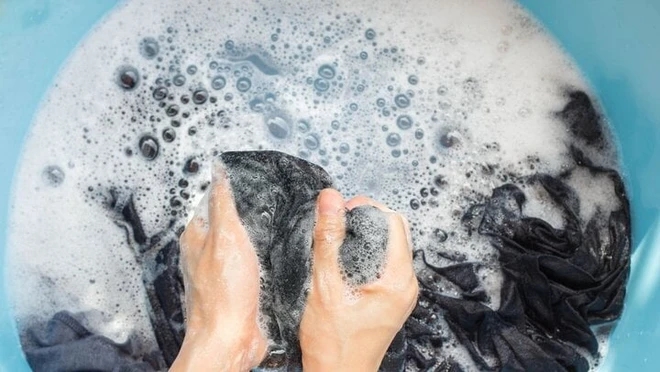Washing clothes is a daily chore, but during the summer, people change their outfits more often, resulting in larger loads of laundry. This is also the time when homemakers look for tips to save electricity and water in their laundry routines.
Tips for efficient laundry: Clean clothes while conserving energy and water.
Keep these tips in mind for summer laundry to ensure clean clothes while saving on your utility bills. Try implementing them in your next wash!
Soak clothes before machine washing

Soaking clothes before machine washing ensures stains are completely removed. (Image: Good Housekeeping)
For clothes with stubborn stains on areas like collars, cuffs, and hems, it’s best to soak and scrub them by hand before putting them in the washing machine. This ensures that the stains are completely removed.
Use the right amount of laundry
The machine operates through the same cycle regardless of the amount of laundry. To avoid wasting electricity, load the machine with an appropriate amount of laundry, not too much or too little. Aim for 70%-80% of the maximum load capacity. This ensures clean clothes while conserving energy and water and prevents damage to the machine.
Select the appropriate wash cycle
While many modern washing machines can automatically select a wash cycle based on the load, they often choose a cycle that uses more water and time than necessary. Manually selecting the wash cycle allows you to save energy. For smaller loads, opt for a gentle cycle with the minimum water level. For larger loads, estimate the appropriate cycle to avoid unnecessary long cycles. Of course, for items like bed sheets, blankets, and pillows, a longer, stronger cycle is necessary.
Adjust the water level accordingly
Most washing machines today have three water levels corresponding to different wash cycles. Depending on the amount of laundry, choose the suitable water level. For smaller loads, select the lowest water level to save water and shorten the wash time, resulting in reduced electricity consumption.
Turn off the hot water setting

Turn off the hot water setting. This summer laundry tip ensures clean clothes and saves energy and water. (Image: CNN)
If your washing machine has a hot water setting, opt for cold water to save energy. The hot water setting requires a significant amount of electricity to heat the water, whereas cold water cycles do not need this process, reducing electricity consumption. Additionally, cold water is suitable for most fabrics and can prolong their lifespan by minimizing shrinkage and color fading.
Choose the right laundry products
Select laundry detergents specifically designed for washing machines, as they offer better cleaning performance than regular detergents and help protect your machine. These detergents produce less foam, leaving less residue on your clothes. Use the right amount of detergent proportional to the load size. Using the correct amount improves cleaning efficiency and saves electricity and water. For heavily soiled garments, pre-soak and scrub them instead of using excessive detergent, as it won’t be effective.
If you use fabric softener, use it wisely to maximize savings. Add the softener during the final cycle and consider pausing the machine for 10 minutes to allow better absorption.
Select the appropriate spin cycle
The spin cycle usually accompanies the pre-set wash program. However, if you want your clothes to dry faster, choose a suitable spin cycle. For thick garments or bedding, select the highest spin speed to save time.
Additionally, to maintain the longevity of your washing machine, avoid placing it in damp areas, and promptly wipe off any water that comes into contact with the control panel.
Avoid peak hours for laundry
Electricity rates are typically higher during peak hours. By doing your laundry during off-peak hours, you can reduce your electricity consumption and save on your utility bills.
Air-dry your clothes

Using an outdoor clothesline and fresh air to dry your laundry instead of a dryer can significantly reduce your electricity costs. (Image: Mosaic lille)
During the summer, take advantage of the warm weather and air-dry your laundry instead of using a dryer. This simple switch can lead to significant savings on your electricity bill.
Properly hanging your clothes on a line can reduce wrinkles, eliminating the need for ironing. The fresh air also helps eliminate detergent residue. When drying clothes outdoors, choose a suitable location away from direct sunlight, as it can fade fragrances from fabric softeners. You can also use the wind to eliminate odors.
Regularly clean your washing machine
Regularly cleaning the drum and maintaining your washing machine not only extends its lifespan but also removes built-up residue, reducing friction during operation. This keeps the machine running smoothly and efficiently, ultimately saving electricity.
According to VTC News

































